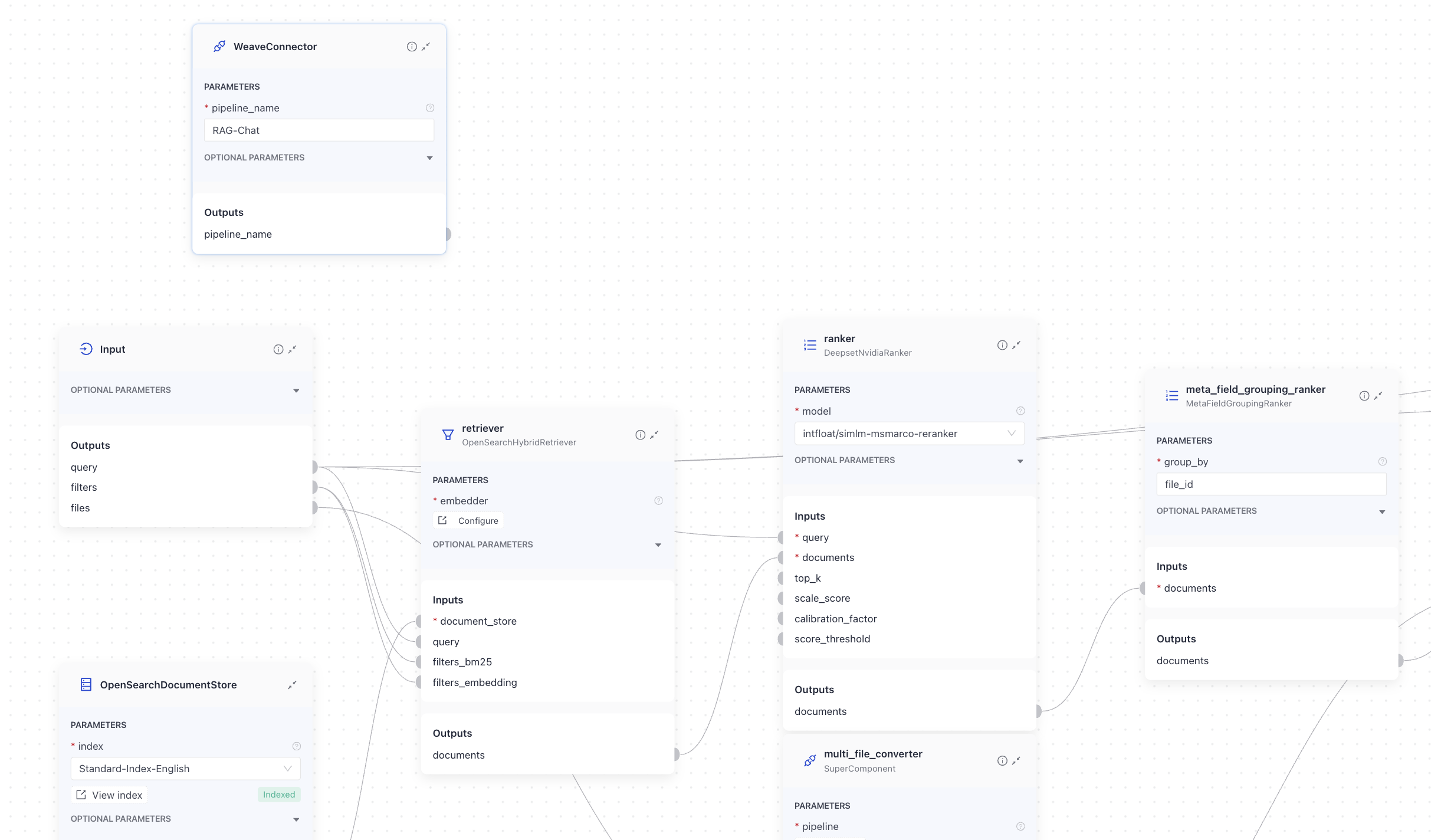WeaveConnector
Collects traces from your pipeline and sends them to Weights & Biases (W&B). Use this component to integrate with the Weights & Biases Weave framework.
Basic Information
- Type:
haystack_integrations.components.connectors.weave.WeaveConnector - Components it can connect with:
WeaveConnectordoesn't connect to any component, you just add it to your pipeline without connecting it to other components.
Inputs
This component takes no inputs.
Outputs
This component produces no outputs.
Overview
WeaveConnector connects deepset AI Platform to Weights & Biases and sends pipeline traces to the Weights & Biases Weave. You can then analyze them in your W&B project. To learn more about Weave, see Weights & Biases documentation.
To trace your pipeline in W&B:
- Connect deepset AI Platform to W&B through the Integrations page. For details, see Use Weights & Biases Services.
- Add
WeaveConnectorto your pipeline without connecting it to any other component, and pass the pipeline name to it.
Usage Example
Using the Component in a Pipeline
In this example, WeaveConnector is added to a RAG-Chat pipeline. It's in the query pipeline but is not connected to any other component. It's sending the traces of the RAG-Chat pipeline to Weights & Biases:

And here's the YAML configuration of the pipeline:
components:
chat_summary_prompt_builder:
type: haystack.components.builders.prompt_builder.PromptBuilder
init_parameters:
template: |-
You are part of a chatbot.
You receive a question (Current Question) and a chat history.
Use the context from the chat history and reformulate the question so that it is suitable for retrieval augmented generation.
If X is followed by Y, only ask for Y and do not repeat X again.
If the question does not require any context from the chat history, output it unedited.
Don't make questions too long, but short and precise.
Stay as close as possible to the current question.
Only output the new question, nothing else!
{{ question }}
New question:
chat_summary_llm:
type: haystack.components.generators.openai.OpenAIGenerator
init_parameters:
api_key: {"type": "env_var", "env_vars": ["OPENAI_API_KEY"], "strict": false}
model: "gpt-4o"
generation_kwargs:
max_tokens: 650
temperature: 0
seed: 0
replies_to_query:
type: haystack.components.converters.output_adapter.OutputAdapter
init_parameters:
template: "{{ replies[0] }}"
output_type: str
bm25_retriever: # Selects the most similar documents from the document store
type: haystack_integrations.components.retrievers.opensearch.bm25_retriever.OpenSearchBM25Retriever
init_parameters:
document_store:
type: haystack_integrations.document_stores.opensearch.document_store.OpenSearchDocumentStore
init_parameters:
embedding_dim: 768
top_k: 20 # The number of results to return
query_embedder:
type: deepset_cloud_custom_nodes.embedders.nvidia.text_embedder.DeepsetNvidiaTextEmbedder
init_parameters:
normalize_embeddings: true
model: "intfloat/e5-base-v2"
embedding_retriever: # Selects the most similar documents from the document store
type: haystack_integrations.components.retrievers.opensearch.embedding_retriever.OpenSearchEmbeddingRetriever
init_parameters:
document_store:
type: haystack_integrations.document_stores.opensearch.document_store.OpenSearchDocumentStore
init_parameters:
embedding_dim: 768
top_k: 20 # The number of results to return
document_joiner:
type: haystack.components.joiners.document_joiner.DocumentJoiner
init_parameters:
join_mode: concatenate
ranker:
type: deepset_cloud_custom_nodes.rankers.nvidia.ranker.DeepsetNvidiaRanker
init_parameters:
model: intfloat/simlm-msmarco-reranker
top_k: 8
qa_prompt_builder:
type: haystack.components.builders.prompt_builder.PromptBuilder
init_parameters:
template: |-
You are a technical expert.
You answer questions truthfully based on provided documents.
Ignore typing errors in the question.
For each document check whether it is related to the question.
Only use documents that are related to the question to answer it.
Ignore documents that are not related to the question.
If the answer exists in several documents, summarize them.
Only answer based on the documents provided. Don't make things up.
Just output the structured, informative and precise answer and nothing else.
If the documents can't answer the question, say so.
Always use references in the form [NUMBER OF DOCUMENT] when using information from a document, e.g. [3] for Document[3].
Never name the documents, only enter a number in square brackets as a reference.
The reference must only refer to the number that comes in square brackets after the document.
Otherwise, do not use brackets in your answer and reference ONLY the number of the document without mentioning the word document.
These are the documents:
{% for document in documents %}
Document[{{ loop.index }}]:
{{ document.content }}
{% endfor %}
Question: {{ question }}
Answer:
qa_llm:
type: haystack.components.generators.openai.OpenAIGenerator
init_parameters:
api_key: {"type": "env_var", "env_vars": ["OPENAI_API_KEY"], "strict": false}
model: "gpt-4o"
generation_kwargs:
max_tokens: 650
temperature: 0
seed: 0
answer_builder:
type: deepset_cloud_custom_nodes.augmenters.deepset_answer_builder.DeepsetAnswerBuilder
init_parameters:
reference_pattern: acm
WeaveConnector:
type: haystack_integrations.components.connectors.weave.WeaveConnector
init_parameters:
pipeline_name: RAG-Chat
connections: # Defines how the components are connected
- sender: chat_summary_prompt_builder.prompt
receiver: chat_summary_llm.prompt
- sender: chat_summary_llm.replies
receiver: replies_to_query.replies
- sender: replies_to_query.output
receiver: bm25_retriever.query
- sender: replies_to_query.output
receiver: query_embedder.text
- sender: replies_to_query.output
receiver: ranker.query
- sender: replies_to_query.output
receiver: qa_prompt_builder.question
- sender: replies_to_query.output
receiver: answer_builder.query
- sender: bm25_retriever.documents
receiver: document_joiner.documents
- sender: query_embedder.embedding
receiver: embedding_retriever.query_embedding
- sender: embedding_retriever.documents
receiver: document_joiner.documents
- sender: document_joiner.documents
receiver: ranker.documents
- sender: ranker.documents
receiver: qa_prompt_builder.documents
- sender: ranker.documents
receiver: answer_builder.documents
- sender: qa_prompt_builder.prompt
receiver: qa_llm.prompt
- sender: qa_prompt_builder.prompt
receiver: answer_builder.prompt
- sender: qa_llm.replies
receiver: answer_builder.replies
inputs: # Define the inputs for your pipeline
query: # These components will receive the query as input
- "chat_summary_prompt_builder.question"
filters: # These components will receive a potential query filter as input
- "bm25_retriever.filters"
- "embedding_retriever.filters"
outputs: # Defines the output of your pipeline
documents: "ranker.documents" # The output of the pipeline is the retrieved documents
answers: "answer_builder.answers" # The output of the pipeline is the generated answers
max_runs_per_component: 100
metadata: {}
Parameters
Init Parameters
These are the parameters you can configure in Pipeline Builder:
| Parameter | Type | Default | Description |
|---|---|---|---|
| pipeline_name | str | The name of the pipeline you want to trace. Used as the name of the Weave project in W&B. We recommend setting it to the name of the pipeline you're tracing. This will make it easier to identify where the traces come from, especially when managing multiple projects. | |
| weave_init_kwargs | dict[str, Any] | None | Additional keyword arguments for Weave. |
Run Method Parameters
This component has no run() method parameters.
Was this page helpful?